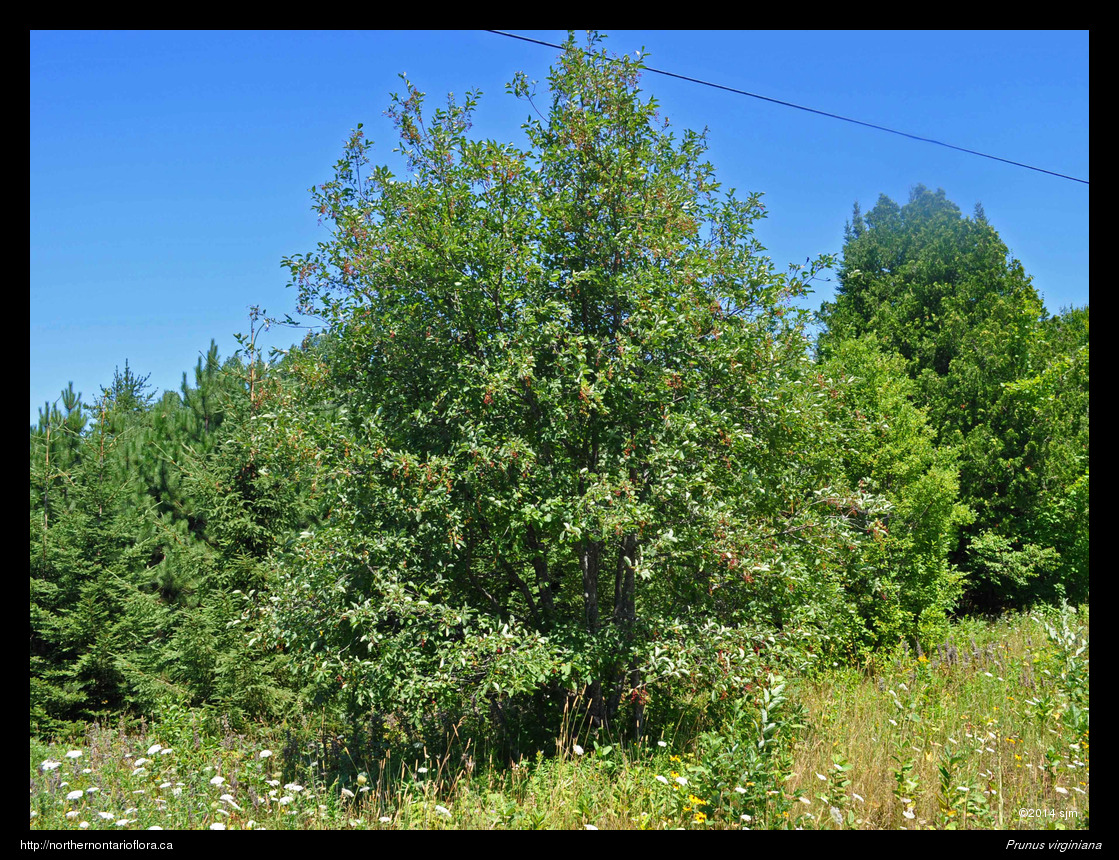
|
Northern Ontario Plant Database 
Plant DescriptionPrunus virginiana L.En: choke cherry, bitter cherry
Rosaceae (Rose Family) General: A coarse deciduous shrub, 2—4 m tall, or rarely a tree to 10 m tall; reproduces vegetatively through rhizomes and often forms dense thickets. Stems/twigs: Bark is dark grayish-brown and smooth, older stems are marked with irregular vertical striations. Twigs are reddish brown to purplish-gray, dotted by small pale lenticels, and, like pin cherry, have a disagreeable bitter almond taste and smell when crushed. Buds are alternate, lanceolate, sharply pointed (acuminate), and have several overlapping bud scales with pale brown to silvery-gray margins. Leaf scars are semicircular with 3 bundle trace scars. Leaves: Alternate, simple, pinnately-veined, petiolate. The petiole, 0.5-2 cm long, is often red and bears minute glands near blade. Leaves are variable in shape; typically they are elliptic or oblong to obovate, 4—12 cm long by 4-6 cm wide, and widest above the middle; however, vigorous root shoots often have much larger leaves, with a leaf shape ranging from ovate to obovate. Leaf blades are dark green and smooth (glabrous) above, paler and usually smooth below, except for the presence of tufts of fine white hairs in the axils of the midrib and secondary veins; bases are broadly tapering to rounded, occasionally slightly cordate; the blade tapers abruptly to a short, pointed (acuminate) apex; and leaf margins are finely toothed (serrulate) with small sharp teeth. Flowers: Bisexual, arranged in elongate racemes, 5-15 cm long, of 10-35+ flowers; flower stalks (pedicels) are 4-8 mm long. The calyx forms a cup-shaped hypanthium that surrounds the single superior ovary. Attached to the rim of the hypanthium are 5 reflexed calyx lobes with an obtuse apex and ragged (erose) to serrate margins, 5 white rounded petals with erose margins, and 20-25 stamens. Flowers bloom shortly after the leaves emerge in May to early June. Fruit: A drooping cluster of small globose cherries (drupes), each 8—10 mm in diameter. Young fruit are bright red, but become deep purple-black when mature. The flesh of the fruit is tart but edible; however, the seed contained within each stony pit should not be eaten. Choke cherry seeds contain significant amounts of hydrogen cyanide, a poisonous compound that can be fatal if ingested in large quantities. This chemical, also found in the young leaves and other plant parts, gives choke and pin cherry twigs their bitter-almond taste. Fruits mature in late summer. Habitat and Range: Moist, open woods, forest edges, disturbed areas, rights-of-way, roadsides, and shores. Choke cherry is native to temperate and boreal North America; its range extends from Newfoundland west to central British Columbia. Choke cherry is found throughout much of Ontario; its range extends north to James Bay. Similar Species: The only other cherry native to Ontario with flowers arranged in racemes is black cherry (Prunus serotina Ehrh.), but it occurs only in southern and eastern Ontario. Black cherry has lanceolate to oblong leaves that taper gradually to an acuminate time, blunt marginal teeth, and on the lower surface of the leaf, tufts of brown hair that line the lower ½ to ⅓ of the midrib. Pin cherry (Prunus pensylvanica L.f.) is also native to northern Ontario, but has narrower lanceolate leaves, flowers borne in umbel-like clusters, and bright red fruit. Back to species list |
||||||||||||||||||||||

























